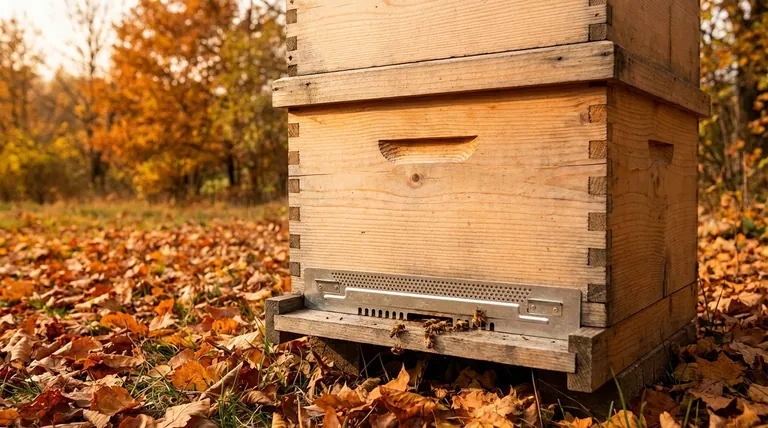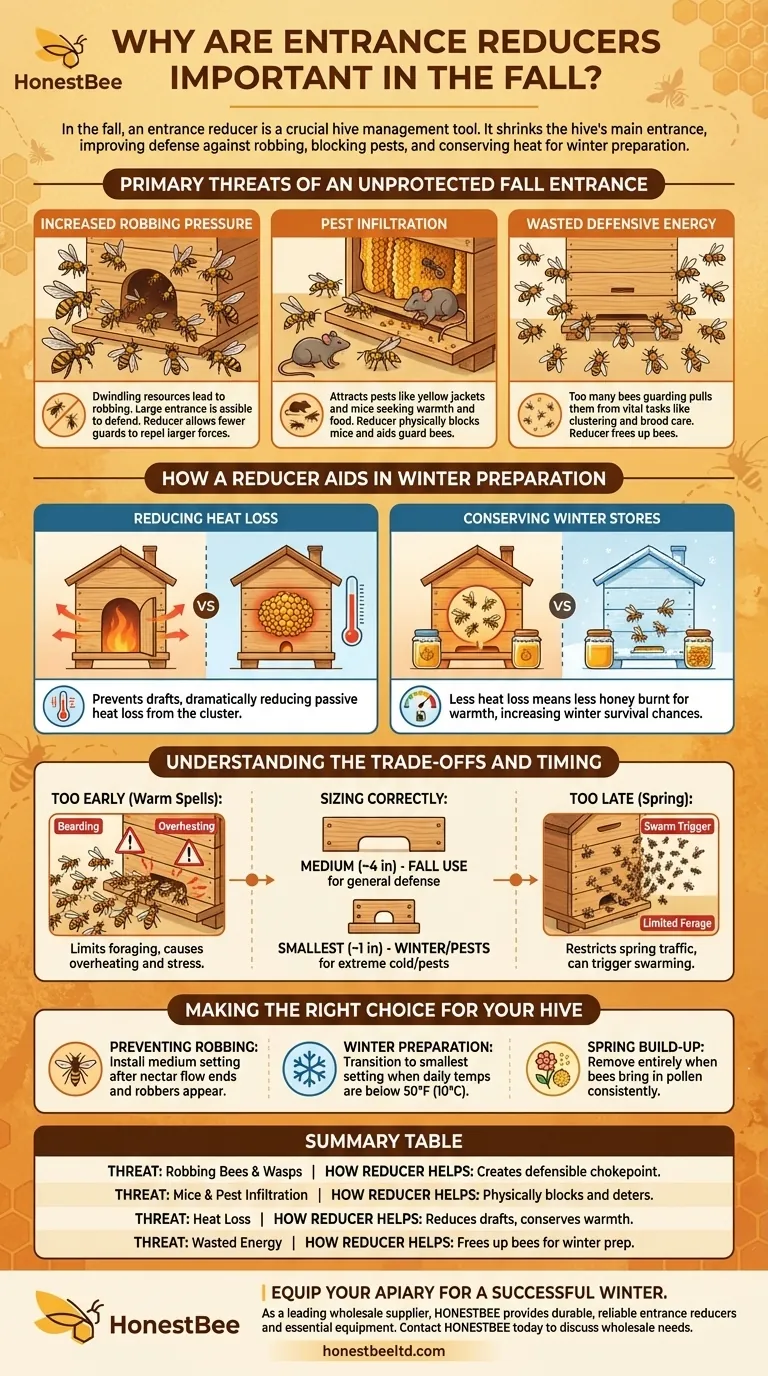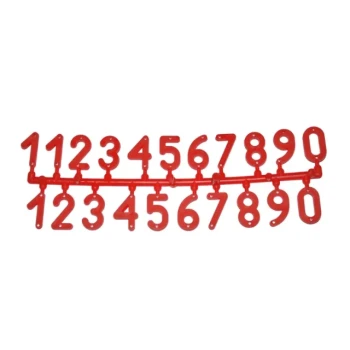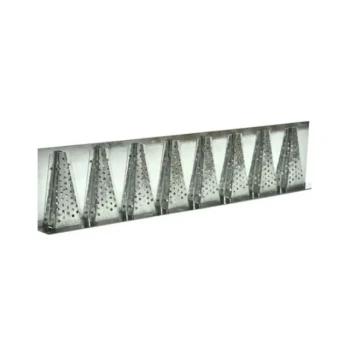In the fall, an entrance reducer becomes one of the most important tools for hive management. It is a simple device that shrinks the hive's main entrance, fundamentally improving a colony's ability to defend itself from robbing, block pests, and conserve precious heat as it prepares for winter.
As a colony's population naturally declines in the autumn, its large summer entrance transforms from an asset into a significant liability. Using an entrance reducer corrects this imbalance, resizing the hive's "front door" to match the colony's reduced defensive capabilities and seasonal needs.

The Primary Threats of an Unprotected Fall Entrance
As outside resources dwindle, your hive becomes a target. A wide-open entrance is an invitation for disaster, and understanding these specific threats reveals why a reducer is not optional, but essential.
Increased Robbing Pressure
With nectar sources disappearing, other honey bee colonies and wasps can turn to "robbing"—stealing the honey stores your bees worked all summer to create.
A large entrance is impossible for a shrinking fall colony to defend effectively. A reducer constricts the battlefield, allowing a small number of guard bees to successfully repel a much larger force.
Pest Infiltration
Your hive offers warmth and food, making it an attractive winter home for pests. The most common invaders are yellow jackets and mice.
A reduced entrance physically blocks mice, which can move in, destroy comb, and urinate in the hive. It also creates a chokepoint that makes it far easier for guard bees to manage opportunistic yellow jackets.
Wasted Defensive Energy
Every bee has a role. When the entrance is too large, more bees must be allocated to guard duty, spreading them thin across a wide perimeter.
This pulls bees away from other vital fall tasks, such as clustering for warmth and caring for the last rounds of brood. A small entrance is a force multiplier, freeing up bees for more critical jobs.
How a Reducer Aids in Winter Preparation
Beyond active defense, an entrance reducer plays a passive but critical role in helping the colony prepare its internal environment for the cold months ahead.
Reducing Heat Loss
A honey bee colony's primary winter goal is thermoregulation—keeping the central cluster warm. A large, open entrance acts like an open door in your house, creating drafts and allowing precious heat to escape.
By shrinking the opening, you dramatically reduce this passive heat loss.
Conserving Winter Stores
Bees generate heat by consuming their honey stores and vibrating their wing muscles. The less heat they lose to the environment, the less honey they need to burn.
An entrance reducer helps the hive retain warmth, directly translating to lower food consumption and a greater chance of the colony having enough honey to survive until spring.
Understanding the Trade-offs and Timing
Using an entrance reducer is about applying the right tool at the right time. Mismanagement can create new problems.
The Risk of Installing Too Early
If you install a reducer during a warm spell or before the main nectar flow has truly ended, you can create a traffic jam.
This bottleneck limits foraging efficiency and can cause overheating inside the hive, stressing the colony and leading to "bearding" (bees clustering on the outside).
The Danger of Forgetting to Remove It
In the spring, a reducer is a liability. As the queen ramps up laying and the colony's population explodes, the small entrance restricts the heavy flight traffic needed for foraging.
This "front porch traffic jam" is a known swarm trigger and will severely limit the colony's ability to bring in the season's first vital nectar flows.
Sizing the Opening Correctly
Most wooden reducers offer two opening sizes—typically around 4 inches and 1 inch. The larger opening is for general fall use, while the smallest opening is for the coldest parts of winter or when dealing with intense robbing or mice pressure.
Making the Right Choice for Your Hive
Apply your reducer based on observable conditions, not just the calendar date.
- If your primary focus is preventing robbing: Install the reducer to its medium setting (e.g., 4 inches) as soon as the main nectar flow ends and you notice wasps or bees from other hives investigating your entrance.
- If your primary focus is winter preparation: Transition to the smallest setting (e.g., 1 inch) once daily temperatures are consistently below 50°F (10°C) and bee flight has mostly ceased. This is your primary defense against mice.
- If your primary focus is spring build-up: Remove the reducer entirely once you see your bees consistently bringing in pollen on warm days, signaling the start of the new season's growth.
Properly managing your hive's entrance is a simple action that has a profound impact on the long-term health and survival of your colony.
Summary Table:
| Threat | How an Entrance Reducer Helps |
|---|---|
| Robbing Bees & Wasps | Creates a defensible chokepoint for guard bees. |
| Mice & Pest Infiltration | Physically blocks entry for mice and deters yellow jackets. |
| Heat Loss | Reduces drafts and helps conserve the colony's warmth. |
| Wasted Energy | Frees up bees from guard duty for critical winter prep tasks. |
Equip your apiary for a successful winter. As a leading wholesale supplier to commercial apiaries and distributors, HONESTBEE provides durable, reliable entrance reducers and other essential beekeeping equipment. Ensure your colonies are protected from robbing and pests while conserving vital heat. Contact HONESTBEE today to discuss your wholesale needs and secure your winter inventory.
Visual Guide

Related Products
- Beehive Entrance Reducer Guardian Metal Hive Entrance for Bees
- Steel Round Disc Entrance Reducer for Flexzion Bee Hive Nuc Box Gate
- Multi-Functional Sliding Hive Entrance for Beekeeping
- Multi-Functional Rotary Hive Entrance Disc for Beekeeping
- Professional Reversible Beehive Hive Entrance
People Also Ask
- What are the different types of entrance reducers available? A Guide to Protecting Your Hive
- How big should a beehive entrance be? Optimize for Colony Health & Honey Production
- What should be done after transferring frames to the new hive? Essential Steps for a Secure Colony
- What are the two functions of the Entrance Reducer? Master Hive Defense and Safe Transport
- What are the features of the side with oblong holes in the entrance reducer? A Guide to Hive Defense & Health



















